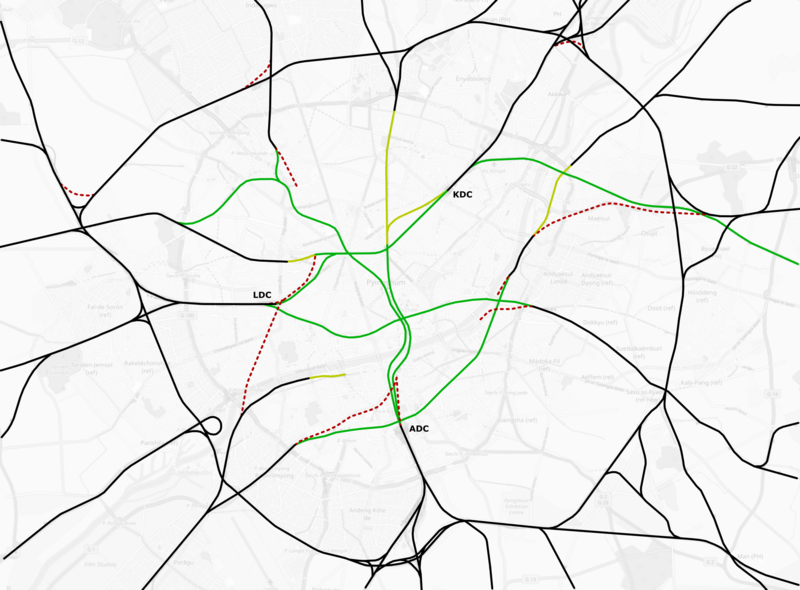Pyingshum: Difference between revisions
| Line 50: | Line 50: | ||
=== Rail Network === | === Rail Network === | ||
[[File:Psm rail dev.png|thumb|800x800px|Historic development of railways in central Pyingshum. Metro and light rail not included.]] | |||
The growth of the railway network is closely tied to the general history of the city. The first lines were built by private companies in the second half of the 19th century, with most companies building one or more terminus stations. Throughout the 20th century, several stations were moved further out of the city center and railway lines extending into the city were dismantled and replaced by underground metro or later Papáchē lines. Limbē-Dyanchezi was opened in 1909 to take over most services to Ozuman Chezi in Daiamondoshi-Pang, Kibō-Dyanchezi in 1929 to replace Humenyamin Chezi, also in Daiamondoshi, and Aku-Dyanchezi in several phases in the 1970's as a replacement for the overburdened old Akuchezi in Doíku-Pang. Also in the 1970's, many suburban railway lines that until this point terminated somewhere on the edge of the inner city were connected with new underground tunnels to form the Papáchē network. | |||
=== Public Transit === | === Public Transit === | ||
Revision as of 16:05, 14 January 2022
Pyingshum (pjiŋɕɯm) is the capital and largest city of Kojo. It is the country's centre of politics, culture and commerce as well as its main transportation hub.
Infobox
Geography and Climate
| Pyingshum | ||||||||||||||||||||||||||||||||||||||||||||||||||||||||||||
|---|---|---|---|---|---|---|---|---|---|---|---|---|---|---|---|---|---|---|---|---|---|---|---|---|---|---|---|---|---|---|---|---|---|---|---|---|---|---|---|---|---|---|---|---|---|---|---|---|---|---|---|---|---|---|---|---|---|---|---|---|
| Climate chart | ||||||||||||||||||||||||||||||||||||||||||||||||||||||||||||
| ||||||||||||||||||||||||||||||||||||||||||||||||||||||||||||
| ||||||||||||||||||||||||||||||||||||||||||||||||||||||||||||
History
City Scape
Architecture, layout and spatial planning, monuments
Demographics
Governance
Mayor and City Government
Election, appointment, person, orga chart
City Council
Election law, makeup, tasks, building,
Dengshōs and Pangs
Pyingshum is made up of nine boroughs (Dengshō), which in turn are divided into a total of xx Pangs. Unlike most other cities in Kojo, not all power is vested in the central city government. Pyingshum is one of only two Kojolese cities that have a second local layer of government on the borough-level. They have some competences in the area of road construction, amenities, ordinances, building permits etc. While elections of the local borough-councils are analogous and simultaneous to the city-council, the borough mayors are not elected by the people directly but instead elected by the respective borough-council. They are also not head of the local administration but instead perform mostly representative functions. Unlike the city council and mayor, sitting on a borough-council or being borough-mayor are honorary offices with small expense allowances instead of fixed remunerations. The borough-councils further appoint members of neighbourhood-boards. They are made up of 5-30 adept residents of the Pang who advise the borough- and sometimes city-council on local matters.
For a list of and information about all Dengshōs and Pangs in the city, refer to the main article: Administrative divisions of Kojo#Pyingshum-sur.
Transportation
Key Data
Road
Many national motorways radiate out from the city. They end at the ca. 40 km long, central ring motorway G100 that encompasses the inner city. Several tangential motorways form a less circular, second ring of motorways through the suburbs.
Since the rise of motorisation, rising motor traffic has been dealt with in two complementary ways: on one hand the city tried to meet the demand by building high-capacity car infrastructure, mostly from the 1940's till 70's, often at the costs of local neighbourhoods. On the other hand, car usage in the inner city has always been discouraged in a number of ways. Since the 60's, many narrow streets in central neighbourhoods have been turned into pedestrian and bike priority or only streets. The vast public transportation network has constantly been upgraded to provide attractive alternatives to the private car. There is virtually no free public parking, and high fees are imposed on car ownership in the inner city in general. Like on most national highways, users have to pay tolls to use them. In Pyingshum during rush hour, additional congestion charges apply which can up to double the toll or even quadruple the toll on the G 100 compared to the national standard. Most of the city is also designated as low-emission vehicle zone. It is possible to buy-out one's vehicle from this ban by paying, depending on the vehicle's emissions, a fee from 3,500 Zubi up to 15,000 Zubi (~600 int$) per month. The car sticker given out to these exempt vehicles is also known as "Daiamondoshi-medal", because most of them belong to a super rich elite who resides in Daiamondoshi-Pang and are willing to pay these exorbitant amounts to be able to show off their prestige cars.
Rail Network
The growth of the railway network is closely tied to the general history of the city. The first lines were built by private companies in the second half of the 19th century, with most companies building one or more terminus stations. Throughout the 20th century, several stations were moved further out of the city center and railway lines extending into the city were dismantled and replaced by underground metro or later Papáchē lines. Limbē-Dyanchezi was opened in 1909 to take over most services to Ozuman Chezi in Daiamondoshi-Pang, Kibō-Dyanchezi in 1929 to replace Humenyamin Chezi, also in Daiamondoshi, and Aku-Dyanchezi in several phases in the 1970's as a replacement for the overburdened old Akuchezi in Doíku-Pang. Also in the 1970's, many suburban railway lines that until this point terminated somewhere on the edge of the inner city were connected with new underground tunnels to form the Papáchē network.
Public Transit
Regional Rail
KCP, KCS and KC
Papáta Huwochē (Suburban)
Chitakyoe Huwochē (Metro)
Shigájanchoel (Light Rail)
Bus Network
Public Transportation Fares
Long-distance Rail
IC and CC
Airfare
Shipping
Economy
Primary Sector
Secondary Sector
Tertiary Sector
Retail, public, service and tourism sector, research, gastronomy
Important Institutions
National and International governmental institutions and NGOs
Education and Research
Schooling
Higher Education
Culture and Leisure
Green Spaces
Parks, Zoo and Botanical Garden, Beaches, environs
